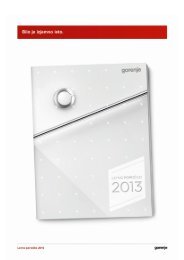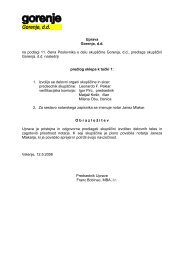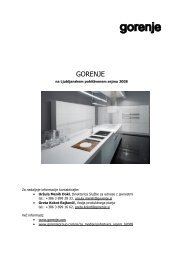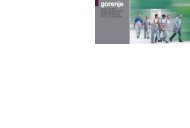ANNUAL REPORT 2008 - Gorenje Group
ANNUAL REPORT 2008 - Gorenje Group
ANNUAL REPORT 2008 - Gorenje Group
You also want an ePaper? Increase the reach of your titles
YUMPU automatically turns print PDFs into web optimized ePapers that Google loves.
98<br />
<strong>2008</strong><br />
hedging of currency risk and the adaptation of business operations to ensure long-term decrease<br />
in currency fluctuation exposure by matching or netting sales and purchases. Additional short-term<br />
hedging is carried out by currency future contracts and short-term borrowings in national currencies.<br />
Irrespective of the implemented hedging measures against currency risk, the management of the<br />
<strong>Gorenje</strong> <strong>Group</strong> estimates that, in the light of significant macroeconomic changes and fluctuations,<br />
in particular of the East-European currencies, the currency risk exposure is high.<br />
In the last few years, a great attention was also paid to interest rate risk, which is the risk that the<br />
economic benefits of the Company may be decreased due to changes in interest rates in the market.<br />
In <strong>2008</strong> the volume of hedging against interest rate risk was decreased over the previous year’s<br />
figure, so that the share of fixed interest rates and derivatives hedging against interest rate risk was<br />
equal to 37.6 percent of the loans portfolio of the <strong>Gorenje</strong> <strong>Group</strong> at the year end <strong>2008</strong>. The management<br />
of the <strong>Gorenje</strong> <strong>Group</strong> estimates that the interest rate risk exposure is high.<br />
Liquidity risk is the risk that the Company will fail to meet commitments in stipulated period of time<br />
due to the lack of available funds.<br />
The financial liabilities of the <strong>Gorenje</strong> <strong>Group</strong> in the amount of EUR 278 million mature in 2009. For<br />
this reason the <strong>Gorenje</strong> <strong>Group</strong> started, in the last quarter of <strong>2008</strong>, to negotiate with the banks the<br />
rescheduling of the existing financial liabilities and thus to decrease the risk of debt rescheduling.<br />
The liquidity reserve at 31.12.<strong>2008</strong> in the amount of EUR 76.6 million, consisting of unused revolving<br />
lines of credit and cash in banks of the <strong>Gorenje</strong> <strong>Group</strong>, is used to ensure adequate short-term<br />
control of cash flows and to decrease short-term liquidity risk.<br />
Short-term liquidity risk of the <strong>Gorenje</strong> <strong>Group</strong> is estimated as increased due to efficient cash management,<br />
adequate available lines of credit for short-term control of cash flows, a high degree of financial<br />
flexibility, and a good access to financial markets and funds. The reason for an increase in<br />
short-term liquidity risk is a decrease in availability of sources of finance from business partners,<br />
both buyers and sellers.<br />
Long-term liquidity risk of the <strong>Gorenje</strong> <strong>Group</strong> is estimated as moderate due to efficient operations,<br />
effective cash management, sustainable ability to generate cash flows from operating activities,<br />
and an adequate capital structure.<br />
The management of the <strong>Gorenje</strong> <strong>Group</strong> estimates that the liquidity risk exposure of the <strong>Gorenje</strong><br />
<strong>Group</strong> is moderate.<br />
Capital management<br />
The <strong>Group</strong>’s policy is to maintain a strong capital base so as to maintain investor, creditor and market<br />
confidence and to sustain future development of the <strong>Gorenje</strong> <strong>Group</strong>. The <strong>Group</strong> monitors the<br />
return on capital, which the <strong>Group</strong> defines, as one of the strategic ratios, as net profit for the period<br />
attributable to equity holders of the <strong>Group</strong> divided by average shareholders’ equity, excluding<br />
minority interests. The <strong>Group</strong> seeks to maintain a balance between the higher returns that might<br />
be possible with higher levels of borrowings and the advantages and security afforded by a sound<br />
capital position.<br />
The dividend policy is based on the investment plans, optimum capital structure policy, and shareholders’<br />
expectations and interests. The amount of dividend per share is proposed by the Management<br />
Board and the Supervisory Board of the controlling company. Dividends are paid from the<br />
accumulated profit of the controlling company determined in accordance with the relevant regulations<br />
in Slovenia. The resolution on the appropriation of accumulated profit is adopted by the<br />
Shareholders’ Meeting.<br />
Pursuant to the resolution of the Shareholders’ Meeting, an own share fund has been formed by the<br />
controlling company of the <strong>Gorenje</strong> <strong>Group</strong> amounting up to 10 % of the share capital. At 31 December<br />
<strong>2008</strong>, the Company recorded 121,311 own shares, which is 0.8647 % of share capital.

















